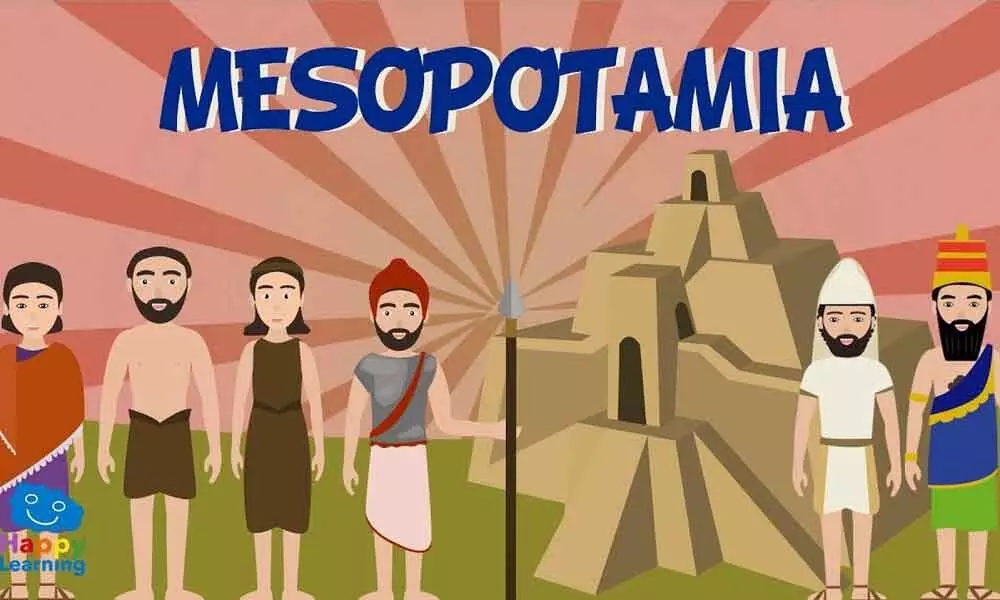The dawn of ancient civilisation

The dawn of ancient civilisation
The word civilisation is etymologically connected to city - it presupposes urban transition. The ancient civilisation is the earliest segment of ancient history
The word civilisation is etymologically connected to city - it presupposes urban transition. The ancient civilisation is the earliest segment of ancient history. The span of earliest history began with the invention of writing about 3000 BC.
In addition to written records, the knowledge about ancient people is derived from the work of archaeologists. The significant archaeological findings have been made in the last two centuries. After development of agriculture in Middle East about 6500 BCE, the human settlements became sedentary in the fertile river valley and people started to domesticate animals.
It is believed that the first ancient civilisation emerged in the Middle East in an area called 'Fertile Crescent' (JH Breasted in 1916) fed by waterways of Euphrates, Tigris and Nile Rivers. Mesopotamian (meso - middle, potamos- river) civilisation is the most ancient civilisation recorded in the human history.
The Fertile Crescent region of Mesopotamia is referred as "Cradle of Civilisation" - location where civilisation has developed independently. This civilisation was formed on the banks of Tigris and Euphrates rivers, today's Iraq and Kuwait, began to form around the time of the Neolithic Revolution - Agricultural Revolution, beginning of the present geological epoch, the Holocene.
The history of Mesopotamia can be looked in; Neolithic Age - the Stone Age (10,000-7000 BCE): There is archaeological confirmation of crude settlements during this time with a shift from hunter-gatherer culture to an agrarian one. As per scholar Stephen Bertman, during this era, stone tools and weapons became more sophisticated. The economy was primarily based on food production through farming and animal rearing.
Chalcolithic Period - Copper Age (5900-3200 BCE) - Owing to the transition from stone tools and weapons to that of Copper. This era includes the Ubaid period, named for Tell al Ubaid, the location in Iraq where large number of artefacts are found, first temples and unwalled villages were developed. These villages then gave rise to urbanisation during Uruk period (4100-2900 BCE).
This period saw the invention of Wheel (3500 BCE) and writing (3000 BCE) by Sumerians, first war of the world recorded between Sumer and Elam (2700 BCE), use of personal seals, cylindrical-seals to denote ownership of property. Bronze Age (3000-1100 BCE) - the rise of city-state laid the foundation of economic and political stability.
The Akkadian Empire of Sargon the Great was the first multi-national realm in the world. The expansion of Assyrian Kingdoms and rise of Babylonian dynasty - created an atmosphere conducive to trade. Hammurabi King of Babylon ruled for four decades, later sacked and looted by Hittites and rise of Kassite Dynasty. Most Mesopotamian States were either destroyed or weakened following the Bronze Age Collapse 1250-1150 BCE.
Mesopotamia was a collection of various cultures whose real bonds were their script, their gods and their attitude towards women. Sumerian civilisation first took form in Southern Mesopotamia around 4000 BCE - the first urban civilisation in the region.
Mesopotamians are noted for first written scripts around 3000 BCE; wedge-shaped marks pressed into clay tablets - the Cuneiform Script - deciphered by scholar George Smith in 1872 CE. Cuneiform is also the script that one of the world's first great works of literature, "The Epic Of Gilgamesh," was written in.
The incredibly important invention of the wheel is also credited to the Sumerians, the earliest wheel dates to 3500 BCE. Sumerians built ship, their religion was polytheistic - worshipped multiple gods - many of which were anthropomorphic.
Temples of gods were constructed atop massive Ziggurats –raised area, broad at bottom, pyramid shaped buildings, had two to seven tiers and each ascending tier smaller than the one under it. In the Akkadian Empire, around 3000 BCE, the Sumerians had significant cultural interchange with a group in Northern Mesopotamians known as Akkadians.
The Akkadian language is related to modern languages of Hebrew and Arabic. Around 2334 BCE, Sargon of Akkad came to power and established the world's first dynastic empire and ruled over both Akkadian and Sumerian.
Babylon was a minor city-state in central Mesopotamia. Hammurabi was an efficient ruler of Babylon's, established centralized bureaucracy with taxation. Hammurabi conquered the whole Southern Mesopotamia and gave the name Babylon to the region.
One of the most important works of Babylon was compilation of a code of laws, around 1754 BCE, called the code of Hammurabi, was improved upon earlier written laws of Sumer, Akkad and Assyria. Hammurabi's code is one of the oldest deciphered writings of significant length in the world.. The Code was written on stone stale-slabs and clay tablets, consisting of 282 laws.
The developments/inventions credited to the Mesopotamians include, but are no means limited to, agriculture, irrigation, domestication of animals, common tools, sophisticated weaponry and warfare, the chariot, religious rites, the sailboats and legal codes.
Orientalist Samuel Noah Kramer in ['fact has listed 39 firsts, from Mesopotamia in his book "History begins at Sumer", in human civilisation that originated in Sumer. To cite few examples - (all prefix first) - the historian, the farmer's almanac, the moral ideals, the proverbs and sayings, the library catalogue, man's golden age, the literary portrait, the aquarium etc.
With the development of wheel and sail, Mesopotamian trade became easier for transportation of goods. Heavy bulk goods could travel by Ox-Cart or be loaded on to riverboats. Most long-distance trade was carried by caravans using donkeys as animals. Trade goods comprising textiles, pottery, leather goods, jewellery, ivory carvings, grains, dates etc were exported.
They established trade all up and down the Tigris and Euphrates into Anatolia - Turkey, over Zagros mountains - Iran and Afghanistan. Sea routes went through Persian Gulf across the Arabian Sea to Indus Valley - Northern India and Pakistan. Mesopotamians were polytheistic as they worshipped several gods. In Sumerian religion, the most powerful and important deities were, the seven gods -An (heaven), Enlil (air), Enki (sea), Ki (earth), Nanna (moon), Utu (sun) and Enanna (goddess of love and war). Religion was central to Mesopotamians as they believed divine affected every aspect of human life.
Looking at Vedic-Ancient Mesopotamian Interconnections - synchronization has been done by Stephen Hillyer Levitt et al. To cite an example: in general, in both the Vedic and 3rd millennium BCE, Sumerian traditions, aspect of nature are deified.
In both, the deification proceeded from deification of natural forces significant in the culture to the anthropomorphic deification of these. In both, the chief god- Indra in the Vedic and Enlil in Sumerian traditions, is god of air and storm, which has been attributed in both traditions by western scholars to the importance of rain and storm.
Mesopotamia was important to Europeans because of the references to it in the Old Testament, the first part of Bible. For instance the Book Of Genesis refers to 'Shimar' - meaning Sumer, as land of brick-built cities. The Legacy of Mesopotamia endures today through many of the most basic aspects of modern life, such as, urbanisation, the wheel, wind power, sixty-second minute and sixty-minute hour.
Helen Chapin Metz writes, the Sumerian believed that each of gods was represented by a number. The number sixty sacred to the god An. Mesopotamia generally, and Sumer specifically, gave the world some of the most enduring cultural aspects, even though the cities and great palaces have long gone, that legacy continued in the modern era.
(The author is a retired IFS officer)










